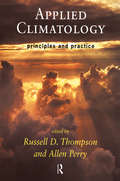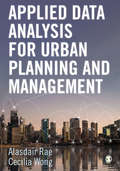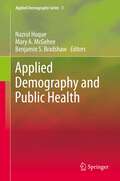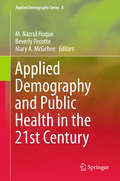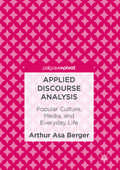- Table View
- List View
Applied Climatology: Principles and Practice
by Allen Perry Dr Russell Thompson Russell Thompson'Big freeze' conditions, storms, severe flooding, droughts, and heatwaves - recent extremes in weather, with their resultant physical, economic and human losses, highlight the vulnerability of society to changes in the atmosphere. Atmospheric pollution, urbanization, natural atmospheric disasters are causing dramatic changes in climatic environments.Applied Climatology examines the effects of climate on physical, biological and cultural environments. Specialist contributors from Europe, North America and Australasia examine the impacts of changing climates on the functioning and development of physical biological environments including glaciers, water resources, landforms, soils, vegetation and animals.Weather and climate effects day-to-day activities and lifestyles from the clothes we wear to the buildings we design, and the food and energy we produce. This book focusses on the relationship between climate and a wide range of human activities and responses relating to health and comfort, building design, transport systems, agriculture and fisheries, tourism and social, industrial and legal issues.Climate-environment relationships and impacts on human activities are predicted to change dramatically if global warming accelerates at the rates currently proposed. Applied Climatology examines the characteristics and consequences of the changing global climate and considers the future for both natural and human environments.
Applied Climatology: Principles and Practice
by Allen Perry Dr Russell Thompson Russell Thompson'Big freeze' conditions, storms, severe flooding, droughts, and heatwaves - recent extremes in weather, with their resultant physical, economic and human losses, highlight the vulnerability of society to changes in the atmosphere. Atmospheric pollution, urbanization, natural atmospheric disasters are causing dramatic changes in climatic environments.Applied Climatology examines the effects of climate on physical, biological and cultural environments. Specialist contributors from Europe, North America and Australasia examine the impacts of changing climates on the functioning and development of physical biological environments including glaciers, water resources, landforms, soils, vegetation and animals.Weather and climate effects day-to-day activities and lifestyles from the clothes we wear to the buildings we design, and the food and energy we produce. This book focusses on the relationship between climate and a wide range of human activities and responses relating to health and comfort, building design, transport systems, agriculture and fisheries, tourism and social, industrial and legal issues.Climate-environment relationships and impacts on human activities are predicted to change dramatically if global warming accelerates at the rates currently proposed. Applied Climatology examines the characteristics and consequences of the changing global climate and considers the future for both natural and human environments.
Applied Communication Research Methods: Getting Started as a Researcher
by Michael Boyle Mike SchmierbachThis third edition is again a practical introduction to communication research methods, foregrounding the role research plays in communication and media industry careers. Covering major methodologies such as surveys, experiments, focus groups, in-depth interviews, content analysis, and others, the book takes the reader through the research process from beginning to end. The text continues to help students link the research methods they learn to practical contexts through its activities and features, which include Voices From Industry boxes written by practitioners that give insight into application of methods; Steps to Success research review checklists; and numerous end-of-chapter activities to reinforce concepts. This third edition contains updates throughout, including an expanded discussion of reliability and validity across both qualitative and quantitative research contexts as well as new Research in Action boxes that showcase how research is used in professional and public contexts. The text is ideally suited to both undergraduate and graduate courses in communication research methods within communication, media, and mass communication programs. Online resources, including sample syllabi, PowerPoint slides, and test banks are available at www.routledge.com/9781032288819.
Applied Communication Research Methods: Getting Started as a Researcher
by Michael Boyle Mike SchmierbachThis third edition is again a practical introduction to communication research methods, foregrounding the role research plays in communication and media industry careers. Covering major methodologies such as surveys, experiments, focus groups, in-depth interviews, content analysis, and others, the book takes the reader through the research process from beginning to end. The text continues to help students link the research methods they learn to practical contexts through its activities and features, which include Voices From Industry boxes written by practitioners that give insight into application of methods; Steps to Success research review checklists; and numerous end-of-chapter activities to reinforce concepts. This third edition contains updates throughout, including an expanded discussion of reliability and validity across both qualitative and quantitative research contexts as well as new Research in Action boxes that showcase how research is used in professional and public contexts. The text is ideally suited to both undergraduate and graduate courses in communication research methods within communication, media, and mass communication programs. Online resources, including sample syllabi, PowerPoint slides, and test banks are available at www.routledge.com/9781032288819.
Applied Crime Analysis: A Social Science Approach to Understanding Crime, Criminals, and Victims
by Wayne PetherickMost approaches to crime analysis focus on geographical crime mapping, which is helpful in identifying crime clusters and allocating police resources, but does not explain why a particular crime took place. Applied Crime Analysis presents a model that brings statistical anchoring, behavioral psychopathology, and victimology from the social sciences together with physical and crime scene evidence to provide a complete picture of crime. This hands-on guide takes theoretical principles and demonstrates how they can be put into practice using real case examples. In addition to covering key topics such as staged crime scenes, false reports, and criminal motivations, the book's includes a final chapter on report writing, showing readers how to use their findings to successfully advance to prosecution and succeed in court. - Presents a model that takes social science concepts, including statistical anchoring, behavioral psychopathology, and victimology and connects them with crime scene evidence to examine and analyze crime - Puts crime analysis theory into practice with real-world examples highlighting important concepts and best practice - Includes a report writing chapter to demonstrate how this approach can strengthen criminal cases and succeed in court - Instructor materials include a Test Bank, Powerpoint lecture slides, and Instructor's Guide for each chapter
Applied Criminology (PDF)
by Brian Williams Brian Stout Dr Joe YatesThis is the first book to cover comprehensively and accessibly the area of applied criminology. It draws together leading experts with experience of teaching, research and practice. Each chapter engages with the application of criminology in a particular area of the community and criminal justice system, and offers: An overview of the relationship between criminological theory and policy and practice developments. Critical reflection on whether criminology has been meaningfully engaged - paying particular attention to the contemporary issues and debates. Evaluation of the implications for diverse communities, paying particular attention to discrimination and oppression and criminal justice values. Summaries, case studies and further reading to support knowledge and understanding. The book is accompanied by a companion website to enhance the learning experience. This includes: Lecture notes Online readings Student exercises Case studies Useful links
Applied Cross-Cultural Data Analysis for Social Work (POCKET GUIDE TO SOCIAL WORK RESEARCH METHODS - PAPER)
by Thanh V. Tran Keith T. ChanApplied Cross-Cultural Data Analysis for Social Work is a research guide for examining and interpreting data for the purpose of cultural group comparisons. This book aims to provide practical applications in statistical approaches of data analyses that are commonly used in cross-cultural research and evaluation. Readers are presented with step-by-step illustrations in the use of descriptive, bivariate, and multivariate statistics to compare cross-cultural population using large-scale, population-based survey data. These techniques have important applications in health, mental health, and social science research relevant to social work and other helping professions, especially in providing a framework of evidence to examine health disparities using population-health data. For each statistical approach discussed in this book, Thanh V. Tran and Keith T. Chan explain the underlying purpose, basic assumptions, types of variables, application of the Stata statistical package, the presentation of statistical findings, and the interpretation of results. Unlike previous guides on statistical approaches and data analysis in social work, this book explains and demonstrates the strategies of cross-cultural data analysis using descriptive and bivariate analysis, multiple regression, additive and multiplicative interaction, mediation, SEM and HLM for subgroup analysis and cross-cultural comparisons. This book also includes sample syntax from Stata for social work researchers to conduct cross-cultural analysis with their own research.
Applied Cross-Cultural Data Analysis for Social Work (POCKET GUIDE TO SOCIAL WORK RESEARCH METHODS - PAPER)
by Thanh V. Tran Keith T. ChanApplied Cross-Cultural Data Analysis for Social Work is a research guide for examining and interpreting data for the purpose of cultural group comparisons. This book aims to provide practical applications in statistical approaches of data analyses that are commonly used in cross-cultural research and evaluation. Readers are presented with step-by-step illustrations in the use of descriptive, bivariate, and multivariate statistics to compare cross-cultural population using large-scale, population-based survey data. These techniques have important applications in health, mental health, and social science research relevant to social work and other helping professions, especially in providing a framework of evidence to examine health disparities using population-health data. For each statistical approach discussed in this book, Thanh V. Tran and Keith T. Chan explain the underlying purpose, basic assumptions, types of variables, application of the Stata statistical package, the presentation of statistical findings, and the interpretation of results. Unlike previous guides on statistical approaches and data analysis in social work, this book explains and demonstrates the strategies of cross-cultural data analysis using descriptive and bivariate analysis, multiple regression, additive and multiplicative interaction, mediation, SEM and HLM for subgroup analysis and cross-cultural comparisons. This book also includes sample syntax from Stata for social work researchers to conduct cross-cultural analysis with their own research.
Applied Crowd Science
by G. Keith StillApplied Crowd Science outlines the theory and applications of the crowd safety course that Prof. Keith Still has developed and taught worldwide for over thirty years. It includes the background and applications of the crowd risk assessment tools, as well as essays and case studies from international users (UK, Ireland, Canada, Australia, Holland, Belgium and Japan). Keith’s courses are mandatory training for all UK Police Public Event Commanders. The text covers legislation and guidance for crowd safety in places of public assembly, and outlines the requirements of a crowd risk assessment for mass gatherings. It draws on Prof. Still’s expert witness experience, highlighting both the problems you need to understand for your event planning.
Applied Crowd Science
by G. Keith StillApplied Crowd Science outlines the theory and applications of the crowd safety course that Prof. Keith Still has developed and taught worldwide for over thirty years. It includes the background and applications of the crowd risk assessment tools, as well as essays and case studies from international users (UK, Ireland, Canada, Australia, Holland, Belgium and Japan). Keith’s courses are mandatory training for all UK Police Public Event Commanders. The text covers legislation and guidance for crowd safety in places of public assembly, and outlines the requirements of a crowd risk assessment for mass gatherings. It draws on Prof. Still’s expert witness experience, highlighting both the problems you need to understand for your event planning.
Applied Cyberpsychology: Practical Applications of Cyberpsychological Theory and Research
by A. Attrill C. FullwoodCyberpsychology is an emerging area of psychological study that aims to understand and explain all facets of online behaviour. This book brings together overviews from a number of leading authorities in the field, to suggest how academic theory and research can be applied to a variety of online behaviours. Both positive and negative behaviours are considered, including topics as diverse as parenting the online child, age-related internet usage and cultural considerations in online interactions. Psychological research can no longer view online and offline worlds as different entities, but must consider online behaviours as equally distinct as offline activities. This is especially apparent when looking at online dating, the role that social networks play in organisations and online consumer behaviours, and in a consideration of the role that psychological research plays in underpinning the multi-billion pound gaming industry. Focusing on these personal applications of the Internet, insight is also offered into the role that theory and research plays in training military personnel as well as the use of psychometric testing to select and retain employees.
Applied Data Analysis for Urban Planning and Management
by Cecilia Wong Alasdair RaeThis book showcases the different ways in which contemporary forms of data analysis are being used in urban planning and management. It highlights the emerging possibilities that city-regional governance, technology and data have for better planning and urban management - and discusses how you can apply them to your research. Including perspectives from across the globe, it’s packed with examples of good practice and helps to demystify the process of using big and open data. Learn about different kinds of emergent data sources and how they are processed, visualised and presented. Understand how spatial analysis and GIS are used in city planning. See examples of how contemporary data analytics methods are being applied in a variety of contexts, such as ‘smart’ city management and megacities. Aimed at upper undergraduate and postgraduate students studying spatial analysis and planning, this timely text is the perfect companion to enable you to apply data analytics approaches in your research.
Applied Data Analysis for Urban Planning and Management
by Cecilia Wong Alasdair RaeThis book showcases the different ways in which contemporary forms of data analysis are being used in urban planning and management. It highlights the emerging possibilities that city-regional governance, technology and data have for better planning and urban management - and discusses how you can apply them to your research. Including perspectives from across the globe, it’s packed with examples of good practice and helps to demystify the process of using big and open data. Learn about different kinds of emergent data sources and how they are processed, visualised and presented. Understand how spatial analysis and GIS are used in city planning. See examples of how contemporary data analytics methods are being applied in a variety of contexts, such as ‘smart’ city management and megacities. Aimed at upper undergraduate and postgraduate students studying spatial analysis and planning, this timely text is the perfect companion to enable you to apply data analytics approaches in your research.
Applied Data Analysis for Urban Planning and Management
This book showcases the different ways in which contemporary forms of data analysis are being used in urban planning and management. It highlights the emerging possibilities that city-regional governance, technology and data have for better planning and urban management - and discusses how you can apply them to your research. Including perspectives from across the globe, it’s packed with examples of good practice and helps to demystify the process of using big and open data. Learn about different kinds of emergent data sources and how they are processed, visualised and presented. Understand how spatial analysis and GIS are used in city planning. See examples of how contemporary data analytics methods are being applied in a variety of contexts, such as ‘smart’ city management and megacities. Aimed at upper undergraduate and postgraduate students studying spatial analysis and planning, this timely text is the perfect companion to enable you to apply data analytics approaches in your research.
Applied Demography: An Introduction To Basic Concepts, Methods, And Data
by Steve H. MurdockThis text aims to help the novice understand demographic variables and analyze their impact on specific private and public sector interests. Examples are employed to demonstrate a wide range of techniques, and the book discusses software products from the 1990 US census that may revolutionize the use of demographic data by business and government.
Applied Demography: An Introduction To Basic Concepts, Methods, And Data
by Steve H. MurdockThis text aims to help the novice understand demographic variables and analyze their impact on specific private and public sector interests. Examples are employed to demonstrate a wide range of techniques, and the book discusses software products from the 1990 US census that may revolutionize the use of demographic data by business and government.
Applied Demography and Public Health (Applied Demography Series #3)
by Nazrul Hoque, Mary A. McGehee and Benjamin S. BradshawThis book combines the disciplines of applied demography and public health by describing how applied demographic techniques can be used to help address public health issues. Besides addressing the impact of aging on health and health-related expenditure, cause-specific mortality, and maternal health and morbidity, the book provides several chapters on special analysis and methodological issues. The chapters provide a number of resources and tools that can be used in conducting research aimed at promoting public health. These resources include information on a variety of health research datasets, different statistical methodologies for analyzing health-related data and developing concepts related to health status, methodologies for forecasting or projecting disease incidences and associated costs, and discussions of demographic concepts used to measure population health status.
Applied Demography and Public Health in the 21st Century (Applied Demography Series #8)
by M. Nazrul Hoque Beverly Pecotte Mary A. McGeheeThis book demonstrates different statistical techniques for analyzing health-related data as well as providing new techniques for forecasting and/or projecting the incidence of diseases/disorders. It presents information on a variety of health related issues from the developed and developing world. Featuring cutting edge research from distinguished applied demographers and public health specialists, the book bridges the gap between theory and research. Each chapter provides methods and materials that can be used to conduct further research aimed at promoting public health issues. This book is intended for public health professionals, health policy makers, social epidemiologists, administrators, researchers, and students in the fields of applied demography and public health who are interested in exploring the potential of ground-breaking research or who want to further develop their existing research techniques. It complements another volume in the Applied Demography Series, Applied Demography and Public Health (Springer, 2013), which describes how applied demographic techniques can be used to help address public health issues.
Applied Demography in the 21st Century: Selected Papers from the Biennial Conference on Applied Demography, San Antonio, Teas, Januara 7-9, 2007
by David A. Swanson Steve H. MurdockThe topic of Applied Demography is clearly evolving as its practitioners become involved in the emerging trends of the Twenty-First Century. This book derived from the first post-2000 national conference on Applied Demography, held in San Antonio, Texas, January 7-9, 2007, at The University of Texas. The conference presented a unique opportunity and this resulting work provides a cross-sectional view of Applied Demography and an evaluation of its likely future.
Applied Developmental Psychology: Volume 2
by Frederick J. Morrison Catherine Lord Daniel P. KeatingApplied Developmental Psychology: Volume 2 is a collection of papers from different experts in the field of psychology in an attempt to put forth a vision of psychology as a developmental science through its applications in different studies. The book covers topics such as essentialism and populational psychology, comprehension and comprehension monitoring, and theoretical and applied issues in the use of binaural sensory aids by blind infants and children. Also covered are topics such as the effects of maternal employment on young children and the subtypes of developmental dyslexia. The text is recommended to psychologists, especially those who would like to research on how the field can be viewed as a developmental science.
Applied Developmental Psychology: Volume 1
by Frederick J. Morrison Catherine Lord Daniel P. KeatingApplied Developmental Psychology is a collection of papers from different experts in the field of psychology in an attempt to put forth a vision of psychology as a developmental science through its applications in different studies. The book covers topics such as the history, the “applied" perspective, and a research strategy for psychology; rationale for the focus and the status of studying, as well as societal and psychological trends related to studying; and the study of the cognitive process related to watching of television. Also covered are topics such as the development of peer relations in children with autism and the studies of stress-resistant children. The text is recommended to psychologists, especially those who would like to research on how the field can be viewed as a developmental science.
Applied Discourse Analysis: Popular Culture, Media, and Everyday Life
by Arthur Asa BergerThis book, written in an accessible style and illustrated with drawings by the author and with many other images, discusses the basic principles of discourse theory and applies them to various aspects of popular culture, media and everyday life. Among the topics it analyzes are speed dating, advertising, jokes, language use, myths, fairy tales and material culture.
Applied Economics in the Digital Era: Essays in Honor of Gary Madden
by James Alleman Paul N. Rappoport Mohsen HamoudiaGary Madden was a renaissance man with respect to the nexus between information and communications technology (ICT) and economics. He contributed to a variety of fields in ICT: applied econometrics, forecasting, internet governance and policy. This series of essays, two of which were co-authored by Professor Madden prior to his untimely death, cover the range of his research interests. While the essays focus on a number of ICT issues, they are on the frontier of research in the sector. Gerard Faulhaber provides a broad overview of how we have reached the digital age and its implications. The applied econometric section brings the latest research in the area, for example Lester Taylor illustrates how own-price, cross-price and income elasticities can be calculated from survey data and translated into real income effects. The forecasting section ranges from forecasting online political participation to broadband’s impact on economic growth. The final section covers aspects of governance and regulation of the ICT sector.
Applied Ethics in Management: Towards New Perspectives (Ethical Economy)
by Samir Ranjan Chatterjee Shitangsu K. ChakrabortyEthical issues are emerging as the most important managerial challenge in all spheres of organizational life, from the wider issues of strategy-making, finance, technology, marketing, information systems to the subtle concerns of gender, demography or cultural diversity. The competitive market-economy model has widened the scope for managers in all countries to violate the fundamental values and integrity needed to maintain and enrich a civil society. These violations stretch from personal lapses of bribery and corruption to the wider areas of moral questions related to an ethically grounded global business system. This book grew out of'a three-day international workshop addressing these issues, held at the Management Centre for Human Values (MCHV), Indian Institute of Management, Calcutta, during February 1998. The workshop explored topics of applied management by providing mUltiple perspectives. Eighteen of the papers have been chosen for this volume, covering business functions, strategies and alliances. One of the key objectives of the workshop was to integrate ideas of applied ethics developing from Asia, Australia and Europe. Any book on applied ethics must be founded on a multicultural base and be practically oriented. This project has been greatly privileged in drawing together the work of 18 very senior and widely experienced academics and practitioners, spanning four continents. The two editors, from different continents, communicated regularly with each other and the contributors. The book is a result of the support and encouragement of many individuals.
Applied Ethnography: Guidelines for Field Research (Developing Qualitative Inquiry)
by Pertti J PeltoThis comprehensive, engaging guide to applied research distills the expertise of the distinguished ethnographer and methodologist Pertti Pelto over his acclaimed 50-year career. Having written the first major text promoting mixed qualitative and quantitative methods in applied ethnography in the 1970s, Pelto now synthesizes decades of innovation, including examples from around the world that illustrate how specific methods yield immediate results for addressing social problems. Ideal for researchers, students, training programs, and technical assistance projects, this thorough text covers the key topics and skills required: gaining entry, recording and organizing field data, a host of specialized techniques, integrating qualitative and quantitative methods, building and training research teams, rapid assessment and focused ethnographic studies, short- and long-term ethnography, writing up results, non-Western perspectives on research, and more.
